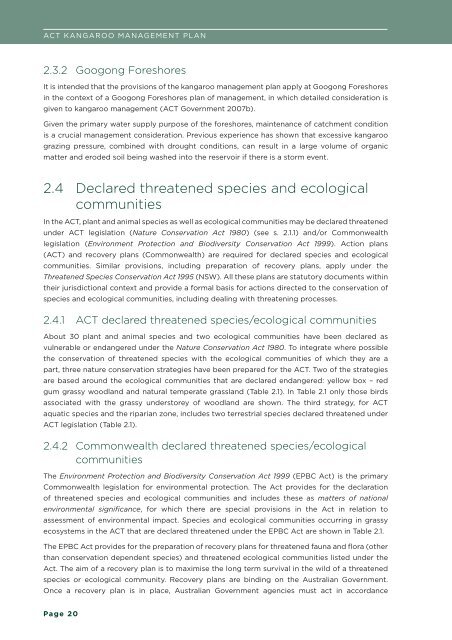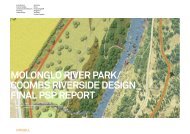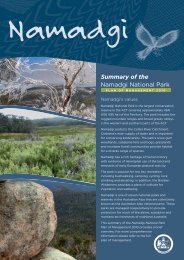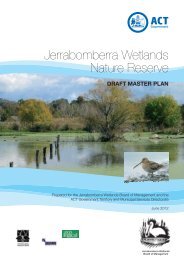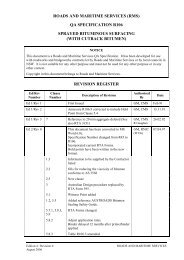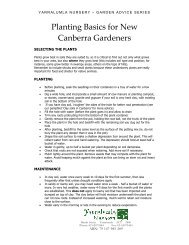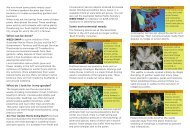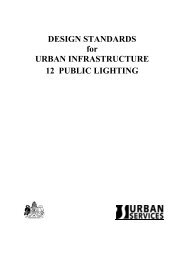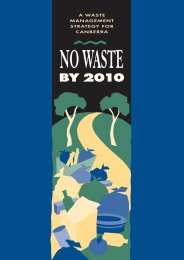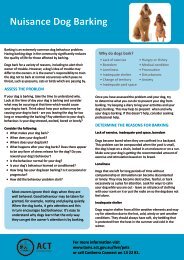Kangaroo Managment Plan - Territory and Municipal Services - ACT ...
Kangaroo Managment Plan - Territory and Municipal Services - ACT ...
Kangaroo Managment Plan - Territory and Municipal Services - ACT ...
Create successful ePaper yourself
Turn your PDF publications into a flip-book with our unique Google optimized e-Paper software.
<strong>ACT</strong> KANGAROO MANAGEMENT PLAN<br />
2.3.2 Googong Foreshores<br />
It is intended that the provisions of the kangaroo management plan apply at Googong Foreshores<br />
in the context of a Googong Foreshores plan of management, in which detailed consideration is<br />
given to kangaroo management (<strong>ACT</strong> Government 2007b).<br />
Given the primary water supply purpose of the foreshores, maintenance of catchment condition<br />
is a crucial management consideration. Previous experience has shown that excessive kangaroo<br />
grazing pressure, combined with drought conditions, can result in a large volume of organic<br />
matter <strong>and</strong> eroded soil being washed into the reservoir if there is a storm event.<br />
2.4 Declared threatened species <strong>and</strong> ecological<br />
communities<br />
In the <strong>ACT</strong>, plant <strong>and</strong> animal species as well as ecological communities may be declared threatened<br />
under <strong>ACT</strong> legislation (Nature Conservation Act 1980) (see s. 2.1.1) <strong>and</strong>/or Commonwealth<br />
legislation (Environment Protection <strong>and</strong> Biodiversity Conservation Act 1999). Action plans<br />
(<strong>ACT</strong>) <strong>and</strong> recovery plans (Commonwealth) are required for declared species <strong>and</strong> ecological<br />
communities. Similar provisions, including preparation of recovery plans, apply under the<br />
Threatened Species Conservation Act 1995 (NSW). All these plans are statutory documents within<br />
their jurisdictional context <strong>and</strong> provide a formal basis for actions directed to the conservation of<br />
species <strong>and</strong> ecological communities, including dealing with threatening processes.<br />
2.4.1 <strong>ACT</strong> declared threatened species/ecological communities<br />
About 30 plant <strong>and</strong> animal species <strong>and</strong> two ecological communities have been declared as<br />
vulnerable or endangered under the Nature Conservation Act 1980. To integrate where possible<br />
the conservation of threatened species with the ecological communities of which they are a<br />
part, three nature conservation strategies have been prepared for the <strong>ACT</strong>. Two of the strategies<br />
are based around the ecological communities that are declared endangered: yellow box – red<br />
gum grassy woodl<strong>and</strong> <strong>and</strong> natural temperate grassl<strong>and</strong> (Table 2.1). In Table 2.1 only those birds<br />
associated with the grassy understorey of woodl<strong>and</strong> are shown. The third strategy, for <strong>ACT</strong><br />
aquatic species <strong>and</strong> the riparian zone, includes two terrestrial species declared threatened under<br />
<strong>ACT</strong> legislation (Table 2.1).<br />
2.4.2 Commonwealth declared threatened species/ecological<br />
communities<br />
The Environment Protection <strong>and</strong> Biodiversity Conservation Act 1999 (EPBC Act) is the primary<br />
Commonwealth legislation for environmental protection. The Act provides for the declaration<br />
of threatened species <strong>and</strong> ecological communities <strong>and</strong> includes these as matters of national<br />
environmental significance, for which there are special provisions in the Act in relation to<br />
assessment of environmental impact. Species <strong>and</strong> ecological communities occurring in grassy<br />
ecosystems in the <strong>ACT</strong> that are declared threatened under the EPBC Act are shown in Table 2.1.<br />
The EPBC Act provides for the preparation of recovery plans for threatened fauna <strong>and</strong> flora (other<br />
than conservation dependent species) <strong>and</strong> threatened ecological communities listed under the<br />
Act. The aim of a recovery plan is to maximise the long term survival in the wild of a threatened<br />
species or ecological community. Recovery plans are binding on the Australian Government.<br />
Once a recovery plan is in place, Australian Government agencies must act in accordance<br />
Page 20


